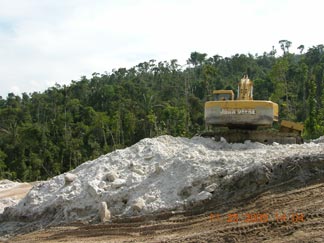 |
QUICK SEARCH
MO PROJECTS:
Africa
Asia/Pacific
Mesoamerica
North America
South America
General Taxonomy
Photo Essays
Training in Latin
America
MO RESEARCH:
Wm. L. Brown Center
Bryology
GIS
Graduate Studies
Research Experiences
for Undergraduates
Imaging Lab
Library
MBG Press
Publications
Climate Change
Catalog Fossil Plants
MO DATABASES:
W³MOST
Image Index
Rare Books
Angiosperm
Phylogeny
Res Botanica
All Databases
INFORMATION:
What's New?
People at MO
Visitor's Guide
Herbarium
Jobs & Fellowships
Symposium
Research Links
Site Map
Search
|
Environmental impacts and conservation issues
|
 |
The Hollín sandstone formation that underlies the plateaus or “tepuis” of the Cordillera del Cóndor is composed of nearly pure crystalline silica, and when the vegetation is removed, the sandstone gleams brilliantly white in the sun. In some places in the Cóndor region where the sandstone plateaus are close to roads, the rock is being mined for manufacture of glass, shipped by truck to factories in several Ecuadorian cities. The mining of silica destroys the unique vegetation of the sandstone plateau with its endemic species. While the impact has been limited so far to a few small areas, silica mining, if expanded significantly, could be a serious threat to the endemic plants of the Cordillera del Cóndor outside of the protected areas. Using Geographic Information System technology and satellite imagery along with his fieldwork, we have mapped the sandstone areas of the Cordillera del Cóndor and are working with the Ministry of Environment of Ecuador and several Ecuadorian non-governmental organizations, to help develop a comprehensive conservation plan for the entire Cóndor region.
In 2006, three new protected areas were declared by the Ministry of Environment in the Cóndor region, and the formally protected areas in the Ecuadorian part of the Cordillera del Cóndor now comprise more than 30,000 hectares. Except for the upper Río Nangaritza area, virtually all of the protected areas include only the sandstone plateaus. The western slopes of the Cordillera del Cóndor, with non-sandstone geological substrates and with vegetation types and floristic elements distinct from the sandstone plateaus, are almost all in private hands (although often without full legal title to the land) and are rapidly being deforested by local residents, to extract timber and establish cattle pastures. Conservation of the western slopes of the Cóndor, if it is to succeed, will require initiatives of the private or non-governmental sector. One initiative is being made by the copper mining company, EcuaCorriente, that is developing plans for a large-scale open-pit copper mine in an area of mineral-rich igneous rocks in the Río Quimi area. As compensation for the environmental impact of the copper mine, the company is planning to purchase and conserve a nearby area of intact forest that includes an altitudinal transect from the sandstone plateau summit at 2000 m elevation, down to the river valley bottom at 900 m, thereby protecting a full range of vegetation types on the western slopes of the Cóndor range.
© 1995-2025 Missouri Botanical Garden, All Rights Reserved
4344 Shaw Blvd.
St. Louis, MO 63110
(314) 577-5100
Technical Support